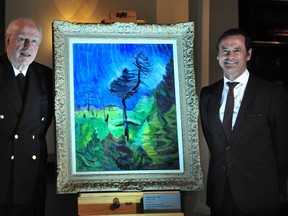The Audain Art Museum in Whistler has a sterling collection of paintings by Emily Carr, including War Canoes, Alert Bay (1912) and The Crazy Stair (The Crooked Staircase, 1928-30).
Art
Audain Art Museum buys Emily Carr painting shown at Venice Biennale

It was painted in 1940, only five years before Carr’s death at age 73. It’s a classic late-period Carr, a swirling, lively work featuring a solitary old tree that’s somehow managed to survive while the forest that used to surround it was either clearcut or burnt.
“It really demonstrates Emily’s concern for the environment, which is a very big concern today,” said Audain, who was on vacation in Thailand when he bought the painting.
The provenance for the painting is impeccable. It was one of four Carr paintings selected by her great champion, Group of Seven painter Lawren Harris, to represent Canada at the 1952 Venice Biennale.
It was the first time Canada had been invited to show work at the Biennale. The other three Carrs from the Biennale are at the National Gallery of Canada and the Art Gallery of Ontario.
Survival has only been exhibited in public three times — at the Vancouver Art Gallery in 1943 and in Montreal in 1959.
“I always had a childhood fascination with (James) Coyne because I used to see his signature on our currency,” said Audain. “I thought that was a marvellous thing, that one could sign these pieces of paper and it would be worth so much money.”
In recent years it’s been owned by a Montreal collector. Because this was a private sale, Audain declined to divulge how much he paid for Survival.
He laughed when he recalled buying the painting sight unseen.
“They sent me an image of the picture, and I thought ‘Oh, it’s an old-timer like me!’ said Audain, 85.
The painting will go on display in April.
Art
40 Random Bits of Trivia About Artists and the Artsy Art That They Articulate – Cracked.com
[unable to retrieve full-text content]
40 Random Bits of Trivia About Artists and the Artsy Art That They Articulate Cracked.com
Source link
Art
John Little, whose paintings showed the raw side of Montreal, dies at 96 – CBC.ca
[unable to retrieve full-text content]
John Little, whose paintings showed the raw side of Montreal, dies at 96 CBC.ca
Source link
Art
A misspelled memorial to the Brontë sisters gets its dots back at last
LONDON (AP) — With a few daubs of a paintbrush, the Brontë sisters have got their dots back.
More than eight decades after it was installed, a memorial to the three 19th-century sibling novelists in London’s Westminster Abbey was amended Thursday to restore the diaereses – the two dots over the e in their surname.
The dots — which indicate that the name is pronounced “brontay” rather than “bront” — were omitted when the stone tablet commemorating Charlotte, Emily and Anne was erected in the abbey’s Poets’ Corner in October 1939, just after the outbreak of World War II.
They were restored after Brontë historian Sharon Wright, editor of the Brontë Society Gazette, raised the issue with Dean of Westminster David Hoyle. The abbey asked its stonemason to tap in the dots and its conservator to paint them.
“There’s no paper record for anyone complaining about this or mentioning this, so I just wanted to put it right, really,” Wright said. “These three Yorkshire women deserve their place here, but they also deserve to have their name spelled correctly.”
It’s believed the writers’ Irish father Patrick changed the spelling of his surname from Brunty or Prunty when he went to university in England.
Raised on the wild Yorkshire moors, all three sisters died before they were 40, leaving enduring novels including Charlotte’s “Jane Eyre,” Emily’s “Wuthering Heights” and Anne’s “The Tenant of Wildfell Hall.”
Rebecca Yorke, director of the Brontë Society, welcomed the restoration.
“As the Brontës and their work are loved and respected all over the world, it’s entirely appropriate that their name is spelled correctly on their memorial,” she said.
The Canadian Press. All rights reserved.
-
News19 hours ago
Freeland says she’s ready to deal with Trump |
-
News19 hours ago
NASA astronauts won’t say which one of them got sick after almost eight months in space
-
News19 hours ago
43 monkeys remain on the run from South Carolina lab. CEO thinks they’re having an adventure
-
News19 hours ago
Freeland rallies a united front ahead of Trump’s return to White House
-
News19 hours ago
Deputy minister appointed interim CEO of AIMCo after Alberta government fires board
-
News19 hours ago
Montreal says Quebec-Canada dispute stalling much-needed funding to help homeless
-
News19 hours ago
S&P/TSX composite index down Friday, Wall St. extends post-election gains
-
News19 hours ago
Mitch Marner powers Matthews-less Maple Leafs over Red Wings